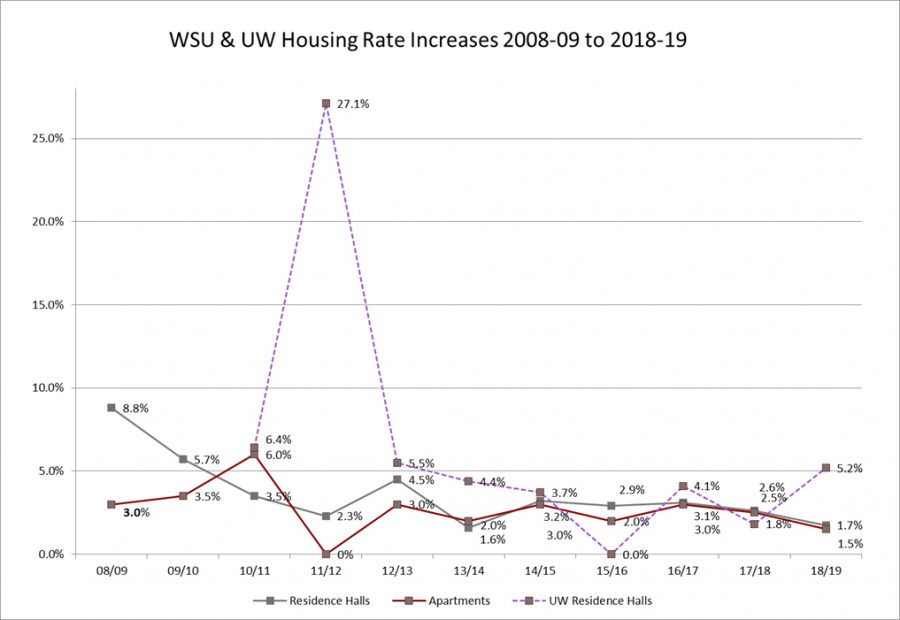WSU housing costs continue to increase
Apartment rates have risen by 1.7 percent, residence halls by 1.8
WSU’s Annual percentage increases over the past 10 years compared to other schools. The line represents both WSU Residence Halls and WSU Apartments.
September 23, 2019
WSU student housing cost rates increased by 1.7 percent for residence halls and 1.8 percent for apartments for the 2018-19 school year, due to the rise in minimum wage and staff salary in Washington.
Sean Greene, executive director for facilities and operations for WSU Housing and Dining, said housing rates have routinely increased for the past 10 years.
WSU apartments and residence halls are a WSU auxiliary, so every time there’s an increase in minimum wage, salary or utility bills, the cost for student housing increases, Greene said.
He said the living costs rise because it allows for student housing to keep up with expenses like utility bills.
Greene said they do not receive any state funding for housing but use student fees to pay the Residence Life staff, custodial staff and other expenses.
“We have to pay for utility costs,” he said, “and we have to pay the trash costs.”
The student housing officials have to pay an administrative service charge, he said.
Petra Nabi, a freshman pursuing elementary education, said the dorm she lives in, Gannon-Goldsworthy, is about $7,000 a semester, not including RDA.
The hall is one of the cheapest on campus but is still too expensive for her and how old the building is, Nabi said.
“The Wi-Fi is not the best,” she said, “but other than that it is nice to have your water paid for because it is already in my dorm plan.”
She said it is worth it to live in the dorms because of the convenience of nearby dining locations and being surrounded by a community.
Greene said they have to generate revenue to offset expenses.
“It is important for us to be financially sound but then at the same time being affordable for students,” he said.
Greene said the cost of living and attendance is important to the students, and student affordability remains an important topic for student housing.
He said if students live in WSU apartments rather than the residence halls, then it can be cheaper depending on the rates.
“A lot of the times, when comparing costs, students look at base rent and our total living arrangements,” Greene said.
Trash, custodial services and Wi-Fi are included in residential housing, and once the costs are added, it is not as expensive considering the services provided, he said.
Greene said the residential housing is currently 98 percent near the occupancy limit.
He said residential housing has an advisory board that evaluates the entire operation, such as WSU Housing and Dining.
The board is made up of seven students that represent ASWSU, GPSA and RHA, along with five faculty or staff members, he said.
If there is a rate increase in student housing, then it is recommended for it to go through the Board of Regents, he said.
Greene said if about 100-200 students who live on campus withdraw from the university and system because of costs or academic reasons, then Housing and Dining Services would face budget issues.
“One-hundred students will affect us by a million dollars,” Greene said.
He said they closely watch the enrollment numbers to determine the occupancy number and will start to track the rates with the advisory board in October.










NateT • Sep 24, 2019 at 4:49 pm
Everyone who rents a room, apartment or house in town, should also keep in mind that when you vote to increase wages or pass a local bond, that cost is initially on property owners, but is eventually passed on to the renters. Housing costs increase when property tax bonds are passed for such things like new computerized medical record systems, or increases to State-wide minimum wages are approved. Its all connected.